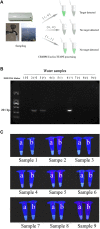CRISPR/Cas12a-Assisted Visual Logic-Gate Detection of Pathogenic Microorganisms Based on Water-Soluble DNA-Binding AIEgens
- PMID: 35096768
- PMCID: PMC8795674
- DOI: 10.3389/fchem.2021.801972
CRISPR/Cas12a-Assisted Visual Logic-Gate Detection of Pathogenic Microorganisms Based on Water-Soluble DNA-Binding AIEgens
Abstract
Here, we developed a rapid, visual and double-checked Logic Gate detection platform for detection of pathogenic microorganisms by aggregation-induced emission luminogens (AIEgens) in combination with Clustered Regularly Interspaced Short Palindromic Repeats (CRISPR)/CRISPR associated (Cas). DNA light-up AIEgens (1,1,2,2-tetrakis[4-(2-bromo-ethoxy) phenyl]ethene, TTAPE) was non-emissive but the emission was turned on in the presence of large amount of DNA produced by recombinase polymerase amplification (RPA). When CRISPR/Cas12a was added, all long-stranded DNA were cut leading to the emission quenched. Thus, a method that can directly observe the emission changes with the naked eye has been successfully constructed. The detection is speedy within only 20 min, and has strong specificity to the target. The result can be judged by Logic Gate. Only when the output signal is (1,0), does it represent the presence of pathogenic microorganisms in the test object. Finally, the method was applied to the detect pathogenic microorganisms in environmental water samples, which proved that this method has high selectivity, specificity and applicability for the detection of pathogenic microorganisms in environmental water samples.
Keywords: CRISPR-Cas12a; aggregation-induced emission (AIE); logic gate; pathogenic microorganisms; visual detection.
Copyright © 2022 Jiao, Yang, Long, Lu, Guo, Peng, Huang, Yin, Song and Zhang.
Conflict of interest statement
YP was employed by the company Pinete (Zhongshan) Biotechnology Co., Ltd. The remaining authors declare that the research was conducted in the absence of any commercial or financial relationships that could be construed as a potential conflict of interest. The handling Editor declared a past co-authorship with one of the authors PZ.
Figures




Similar articles
-
AND Logic-Gate-Based CRISPR/Cas12a Biosensing Platform for the Sensitive Colorimetric Detection of Dual miRNAs.Anal Chem. 2022 Nov 15;94(45):15839-15846. doi: 10.1021/acs.analchem.2c03666. Epub 2022 Nov 1. Anal Chem. 2022. PMID: 36318504
-
Isothermal Amplification and CRISPR/Cas12a-System-Based Assay for Rapid, Sensitive and Visual Detection of Staphylococcus aureus.Foods. 2023 Dec 11;12(24):4432. doi: 10.3390/foods12244432. Foods. 2023. PMID: 38137236 Free PMC article.
-
Development of a Rapid and Efficient RPA-CRISPR/Cas12a Assay for Mycoplasma pneumoniae Detection.Front Microbiol. 2022 Mar 15;13:858806. doi: 10.3389/fmicb.2022.858806. eCollection 2022. Front Microbiol. 2022. PMID: 35369478 Free PMC article.
-
CRISPR-Cas12a System for Biosensing and Gene Regulation.Chem Asian J. 2021 Apr 19;16(8):857-867. doi: 10.1002/asia.202100043. Epub 2021 Mar 18. Chem Asian J. 2021. PMID: 33638271 Review.
-
CRISPR-Cas13: A new technology for the rapid detection of pathogenic microorganisms.Front Microbiol. 2022 Oct 28;13:1011399. doi: 10.3389/fmicb.2022.1011399. eCollection 2022. Front Microbiol. 2022. PMID: 36386639 Free PMC article. Review.
Cited by
-
Recombinase Polymerase Amplification-Based Biosensors for Rapid Zoonoses Screening.Int J Nanomedicine. 2023 Nov 6;18:6311-6331. doi: 10.2147/IJN.S434197. eCollection 2023. Int J Nanomedicine. 2023. PMID: 37954459 Free PMC article. Review.
References
-
- Chen Y., Lam J. W. Y., Kwok R. T. K., Liu B., Tang B. Z. (2018). Aggregation-Induced Emission: Fundamental Understanding and Future Developments. Mater. Horiz. 6, 428–433. 10.1039/c8mh01331d - DOI
LinkOut - more resources
Full Text Sources
Molecular Biology Databases

